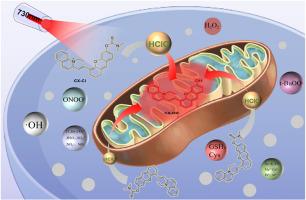A mitochondria-targeted near-infrared fluorescent probe for HClO imaging in living cells and zebrafish
IF 4.2
3区 工程技术
Q2 CHEMISTRY, APPLIED
引用次数: 0
Abstract
Hypochlorous acid (HClO), a crucial reactive oxygen species (ROS), plays dual roles in biological systems, serving as an immune defense agent and a potential cytotoxic mediator. Excessive accumulation of HClO is closely associated with various inflammatory diseases and tissue damage, necessitating the development of sensitive and selective detection tools. In this study, we developed a mitochondria-targeted near-infrared (NIR) fluorescent probe, CX-Cl, for real-time visualization of HClO in living systems. The probe integrates a mitochondria-anchoring quinolinium group with an NIR xanthene derivative, enabling precise subcellular localization and deep-tissue imaging. A HClO-specific oxidative cleavage mechanism triggers a marked NIR fluorescence “turn-on” response (λem = 763 nm) with ultrahigh sensitivity (LOD = 0.19 μM) and selectivity over other analytes. Probe CX-Cl successfully visualized exogenous and endogenous HClO fluctuations in HepG2 cells and zebrafish during lipopolysaccharide-induced inflammation.

线粒体靶向近红外荧光探针在活细胞和斑马鱼中的HClO成像
次氯酸(HClO)是一种重要的活性氧(ROS),在生物系统中具有双重作用,既是免疫防御剂,又是潜在的细胞毒性介质。HClO的过度积累与各种炎症性疾病和组织损伤密切相关,因此需要开发敏感和选择性的检测工具。在这项研究中,我们开发了一种线粒体靶向近红外(NIR)荧光探针CX-Cl,用于实时可视化生命系统中的HClO。该探针集成了线粒体锚定喹啉基团和近红外杂蒽衍生物,可实现精确的亚细胞定位和深部组织成像。hcl特异性氧化裂解机制触发了显著的近红外荧光“开启”响应(λem = 763 nm),具有超高的灵敏度(LOD = 0.19 μM)和选择性。探针CX-Cl成功地可视化了脂多糖诱导炎症期间HepG2细胞和斑马鱼体内外源性和内源性HClO的波动。
本文章由计算机程序翻译,如有差异,请以英文原文为准。
求助全文
约1分钟内获得全文
求助全文
来源期刊

Dyes and Pigments
工程技术-材料科学:纺织
CiteScore
8.20
自引率
13.30%
发文量
933
审稿时长
33 days
期刊介绍:
Dyes and Pigments covers the scientific and technical aspects of the chemistry and physics of dyes, pigments and their intermediates. Emphasis is placed on the properties of the colouring matters themselves rather than on their applications or the system in which they may be applied.
Thus the journal accepts research and review papers on the synthesis of dyes, pigments and intermediates, their physical or chemical properties, e.g. spectroscopic, surface, solution or solid state characteristics, the physical aspects of their preparation, e.g. precipitation, nucleation and growth, crystal formation, liquid crystalline characteristics, their photochemical, ecological or biological properties and the relationship between colour and chemical constitution. However, papers are considered which deal with the more fundamental aspects of colourant application and of the interactions of colourants with substrates or media.
The journal will interest a wide variety of workers in a range of disciplines whose work involves dyes, pigments and their intermediates, and provides a platform for investigators with common interests but diverse fields of activity such as cosmetics, reprographics, dye and pigment synthesis, medical research, polymers, etc.
 求助内容:
求助内容: 应助结果提醒方式:
应助结果提醒方式:


